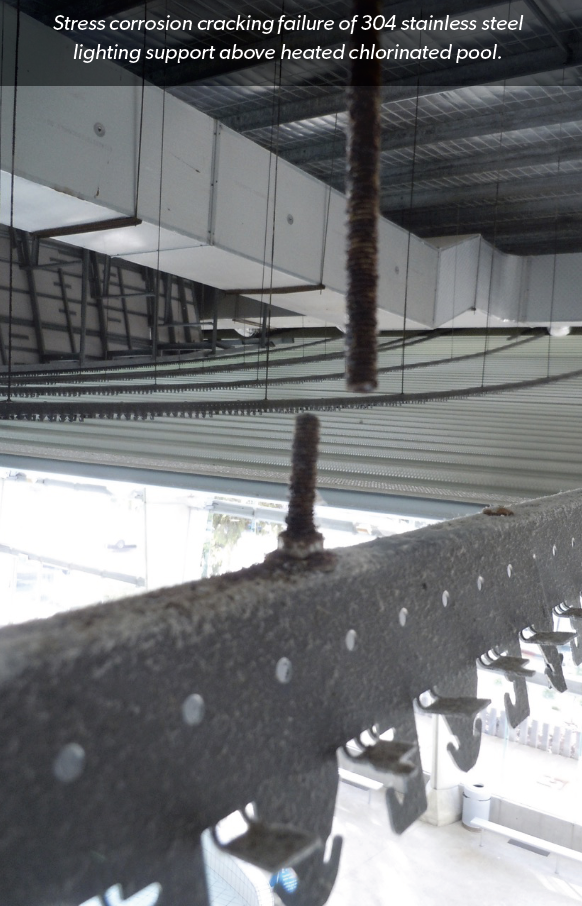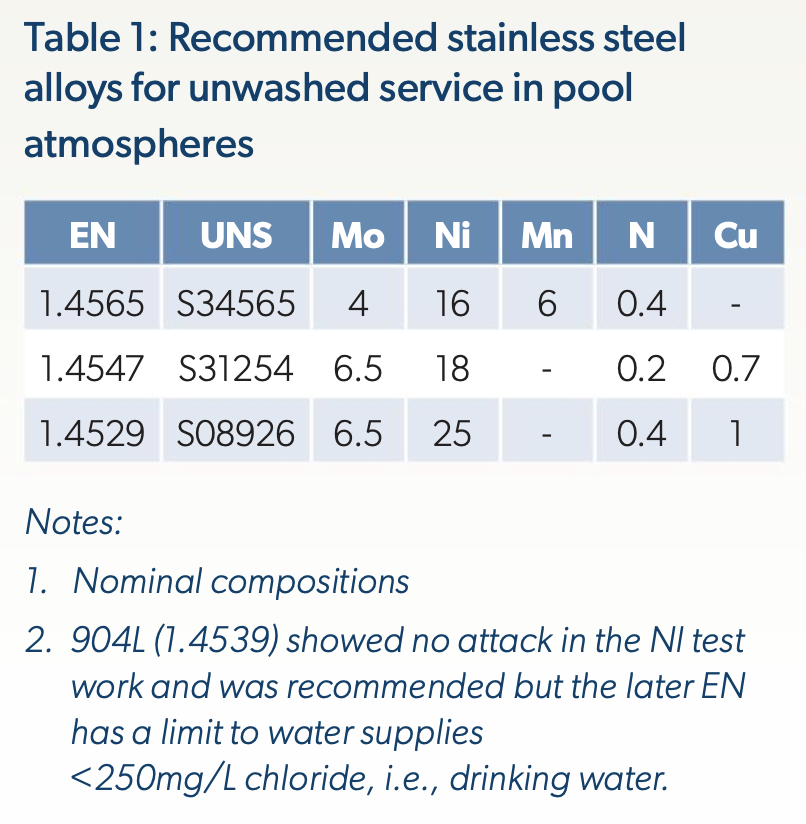
Stainless steels are almost universally used around indoor and exterior pools for railings around or into the water, fixtures, furniture, grills, etc. The finishes are bright and readily cleanable for hygiene and are resistant to staining or corrosion by the chemical treatments required for the maintenance of public health.
This article discusses the unexpected problem (and the solutions) that showed up in the 1980s because of the changing design and operation of indoor heated and chlorinated swimming pools when combined with the increased use of stainless steels as structural supports in the ceilings over pools. The problem: 304/316 stainless steel rods/bolts/wires with surface tensile stresses cracked and broke in high-up, unwashed areas because of a previously unknown, ambient temperature stress corrosion cracking (SCC) mechanism - and, literally, several roofs fell into pools. There are multiple mitigating actions, but a certain solution is to use readily available higher alloys which do not suffer SCC at near-ambient temperatures.
What was new?
There were four factors and a lack of knowledge:
- More water vapour in the airspace because of demands for warmer water temperatures overwhelmed the dehumidification of the air conditioning systems and increased the risk of condensation on cooler metal surfaces.
- Because of greater patronage, there are hygienic requirements for higher chlorine dosing and/or more shock dosing which increases the volatile content in the airspace which then dissolved in the condensed water films.
- In areas that were not washed (e.g. tension rods and bracing in the roof space, ceiling-mounted fans, air conditioning ducts, light fittings, suspended ceilings, signage, and suspension wires), the condensed water film dissolved the volatile chlorides and became very aggressive with Leo (acidic) pH and high chloride concentration.
- An increasing use of stainless steel in load-carrying service.
The knowledge gap was that the chloride-induced SCC of the common 300-series stainless steels was only considered to be a risk for temperatures above 55oC, e.g. on the outside of leaking hot water systems or in the residual stress along welds or the water line of a hot water tank.
The investigations and alloy recommendations
There was a basic assumption that there would always be components subject to surface tensile stress,
so materials testing was required to select alloys resistant to SCC in the pool atmosphere environment. The Nickel Institute (NI) funded research work in the 1990s to identify the mechanism of failure and recommend suitable alloys and operating techniques to prevent recurrence. The results were published in Stainless steel in swimming pool buildings (NI 12010, 1995) and recommended 904L or 6% molybdenum alloys. It did not recommend 2205 duplex stainless steel because there was some pitting in the ferrite phase, although no cracking was observed. ASSDA published a Technical Alert in 2001 which was mainly based on the NI data. It included recommendations for resistant alloys, pool management and inspections to detect possible risks.
The 2003 German building code mandates using high molybdenum alloys listed below (the ~6% Mo austenitic alloys) for unwashed stainless steel applications. The codified alloys are listed in EN 134511:2011 - Swimming Pool Equipment, Appendix G (see summary Table 1 below).
Euro Inox summarised these and further work in their 2013 publication, Safe use of stainless steel in swimming pool environments. They have also been multiple summary engineering papers including lists of readily washed components that can use high austenitic alloys with various molybdenum, nickel, and nitrogen content. Research continues into the use of duplex grades.
The message about alloy choice has had good penetration although those new to stainless steel for indoor chlorinated pools still suggest 316 bolts to support overhead spotlights, 316 bolts over heavily chlorinated wastewater tanks or 316 cables or struts to hang water slides. There were cases of fabricators substituting 304 hangers for the specified painted and galvanised hangers for pool lighting panels - which sagged when several broke as shown in the picture below.
When is SCC not an issue?
When a high austenitic alloy is used for unwashable areas above warm, chlorinated pools. However, one state has satisfactorily used chloramines for potable water disinfection since the 1930s. This is probably because the required dose for disinfection at ambient temperatures is significantly lower than the inadvertent chloramine levels in the atmosphere above a warm pool overpopulated with unwashed bodies.
For external pools subject to wind and rain there is no potential for concentration of chloramines. This means 304/316 around external pools are not at risk from SCC although routine washing is recommended to maintain a bright stainless appearance. Higher grades such as duplex may be required in marine environments, especially for unwashed components such as fastenings of glass panels - simply to avoid tea staining.
The risk of SCC of low alloy stainless steels in the atmosphere only arises with warm chlorinated pools. Pools that only use ozone as a disinfectant are not at risk because ozone is readily reduced to oxygen and does not accumulate like chlorine or chloramines. However, if a shock or backup chlorination procedure is used, then the recommendations of this article should be followed.
When are lower alloy (304/316) stainless steels satisfactory?
In the vast majority of typical stainless steel components regularly drenched, or which aren't under tensile stress, such as benches, pool ladders, safety rails, doors and windows, and non-safety critical components that will be washed for aesthetics. SCC has not been found to be a problem in these applications.
Ongoing actions to reduce and/or eliminate the risk of SCC
- Monitor and control pool chemical levels including chlorine and amines.
- Prevent excessive bathing loads - which may vary with monitoring results.
- Provide good shower and toilet facilities with clear instructions to patrons for use prior to entering the pool.
- Monitor and control air quality. This may require advice from the design and installation contractors.
- Institute a regular inspection and cleaning program - preferably biannual.
- If not already identified, log items potentially at risk.
- If a program has been established, review it to check it covers possible new items, e.g. changed light fittings, signs or hangers.
- If records show consistent excursions from chemical control levels, review processes.
Typical inspection and cleaning plan
If the initial survey identified low alloy stainless steel components in safety-critical locations, then either replace them with high alloy components or arrange a close inspection.
- Clean surface debris with fresh water - not just a wipe and cloth.
- If rust stains are present, consider replacement.
- If there are no stains, stress corrosion cracks can be very fine and require x10 examination or even dye penetrant assessment.
- Clips and wires are normally under tension and should be flexed to determine their integrity.
Cautiously test fasteners by loosening and retightening to the same load.


This article is featured in Australian Stainless Magazine Issue 76 (2022).